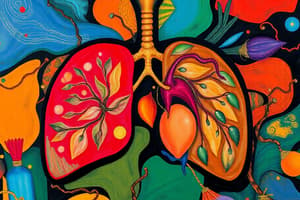Podcast
Questions and Answers
Which process is primarily responsible for breaking down complex food molecules?
Which process is primarily responsible for breaking down complex food molecules?
- Digestion (correct)
- Photosynthesis
- Transportation
- Respiration
What term describes the observable characteristics of an organism influenced by both genotype and environment?
What term describes the observable characteristics of an organism influenced by both genotype and environment?
- Phenotype (correct)
- Genotype
- Dominant trait
- Recessive trait
Which system is responsible for transmitting information rapidly in animals?
Which system is responsible for transmitting information rapidly in animals?
- Respiratory system
- Nervous system (correct)
- Circulatory system
- Endocrine system
Which of the following is NOT a method of asexual reproduction?
Which of the following is NOT a method of asexual reproduction?
In genetics, what describes a trait that is expressed even in the presence of a recessive allele?
In genetics, what describes a trait that is expressed even in the presence of a recessive allele?
What is the main role of hormones in the endocrine system?
What is the main role of hormones in the endocrine system?
Which component carries the genetic code in an organism?
Which component carries the genetic code in an organism?
What aspect of heredity pertains to changes in the genetic sequence?
What aspect of heredity pertains to changes in the genetic sequence?
Which of the following best defines metabolism in living organisms?
Which of the following best defines metabolism in living organisms?
What is the purpose of control and coordination in an organism?
What is the purpose of control and coordination in an organism?
What is the role of abiotic factors in an ecosystem?
What is the role of abiotic factors in an ecosystem?
Which of the following statements about environmental conservation is accurate?
Which of the following statements about environmental conservation is accurate?
How do ecosystems demonstrate the interplay between biotic and abiotic factors?
How do ecosystems demonstrate the interplay between biotic and abiotic factors?
Which environmental issue is most directly linked to human activity?
Which environmental issue is most directly linked to human activity?
Why is the balance of ecosystems vital for living organisms?
Why is the balance of ecosystems vital for living organisms?
Which of the following best describes ecology?
Which of the following best describes ecology?
What factors fall under biotic components of an ecosystem?
What factors fall under biotic components of an ecosystem?
Which consequence of pollution primarily affects the biodiversity of an ecosystem?
Which consequence of pollution primarily affects the biodiversity of an ecosystem?
In what way can human activities negatively influence abiotic factors?
In what way can human activities negatively influence abiotic factors?
Which of the following best describes the relationship between organisms and their environment?
Which of the following best describes the relationship between organisms and their environment?
Flashcards
Metabolism
Metabolism
All the chemical reactions that happen within a living organism.
Photosynthesis
Photosynthesis
The process by which plants use sunlight, water, and carbon dioxide to produce glucose (sugar) for energy.
Digestion
Digestion
The breakdown of food molecules into smaller, simpler molecules that the body can absorb and use.
Respiration
Respiration
Signup and view all the flashcards
Transportation
Transportation
Signup and view all the flashcards
Excretion
Excretion
Signup and view all the flashcards
Heredity
Heredity
Signup and view all the flashcards
Genes
Genes
Signup and view all the flashcards
DNA
DNA
Signup and view all the flashcards
Reproduction
Reproduction
Signup and view all the flashcards
Environment
Environment
Signup and view all the flashcards
Abiotic Factors
Abiotic Factors
Signup and view all the flashcards
Biotic Factors
Biotic Factors
Signup and view all the flashcards
Ecosystem
Ecosystem
Signup and view all the flashcards
Organism-Environment Interactions
Organism-Environment Interactions
Signup and view all the flashcards
Environmental Issues
Environmental Issues
Signup and view all the flashcards
Environmental Conservation
Environmental Conservation
Signup and view all the flashcards
Ecology
Ecology
Signup and view all the flashcards
Human Impact on the Environment
Human Impact on the Environment
Signup and view all the flashcards
Ecosystem Balance
Ecosystem Balance
Signup and view all the flashcards
Study Notes
Biology - Life Processes
- Life processes are the fundamental activities that living organisms perform to maintain life.
- Examples include nutrition, respiration, transportation, excretion, movement, control and coordination.
- Metabolism encompasses all chemical reactions that occur within an organism.
- Photosynthesis is a crucial process for plants, converting light energy into chemical energy.
- Digestion breaks down complex food molecules into simpler substances.
- Respiration releases energy from food molecules, often in the form of ATP.
- Transportation moves materials within the body, like nutrients and oxygen.
- Excretion removes waste products from the organism.
- Movement and locomotion allow organisms to respond to stimuli and interact with their environment.
Heredity
- Heredity involves the transmission of traits from parents to offspring.
- Genes are the basic units of heredity, located on chromosomes.
- DNA is the molecule that carries the genetic code.
- Chromosomes carry the DNA and are organized structures found in the cell nucleus.
- Dominant traits are expressed even in the presence of a recessive allele.
- Recessive traits are only expressed when two recessive alleles are present.
- Genotype refers to the genetic makeup of an organism.
- Phenotype refers to the observable characteristics of an organism, determined by the interaction between genotype and environment.
- Mendelian genetics describes patterns of inheritance.
- Non-Mendelian inheritance exists alongside Mendel's laws, showcasing more complex inheritance patterns.
- Gene mutations can affect the genetic code and lead to variations.
Control and Coordination
- Control and coordination are essential for maintaining homeostasis and responses to stimuli.
- In animals, the nervous system and endocrine system play vital roles.
- The nervous system uses nerve impulses to transmit information rapidly.
- The endocrine system uses hormones to regulate body functions, often more slowly than the nervous system.
- Plants use chemical and electrical signals to coordinate growth and responses.
Reproduction
- Reproduction is the process by which living organisms create new individuals of their kind.
- Asexual reproduction does not involve the fusion of gametes, resulting in genetically identical offspring.
- Sexual reproduction involves the fusion of male and female gametes, creating genetically diverse offspring.
- Asexual reproduction methods include binary fission, budding, fragmentation, vegetative propagation, and spore formation.
- Sexual reproduction methods include internal and external fertilization.
- Reproduction is essential for the continuation of species. Variations are essential for the survival of a species in a changing environment.
Environment
- The environment encompasses all living and non-living factors around an organism.
- The environment plays a crucial role in shaping organism characteristics, interactions, adaptations, and distribution.
- Abiotic factors include non-living things such as temperature, water, sunlight, and soil.
- Biotic factors include all living things, including plants, animals, and microorganisms.
- Ecosystems are composed of biotic and abiotic factors and are interconnected.
- The environment impacts organisms, and organisms impact the environment.
- Examples of environmental issues are pollution, deforestation, climate change, and biodiversity loss.
- Environmental conservation involves the protection and sustainable use of natural resources.
- Human activity significantly influences the environment.
- The delicate balance of ecosystems is vital for the well-being of all living things.
- Ecology is the study of the interactions between organisms and their environment.
Studying That Suits You
Use AI to generate personalized quizzes and flashcards to suit your learning preferences.




